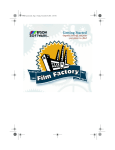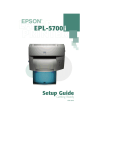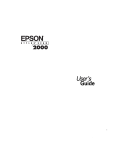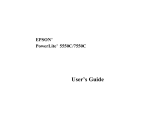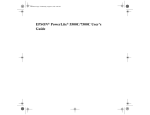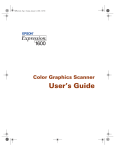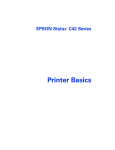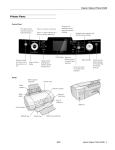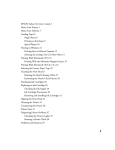Download Epson Software Film Factory User's Manual
Transcript
Copyright Notice All rights reserved. No part of this publication may be reproduced, stored in a retrieval system, or transmitted in any form or by any means, electronic, mechanical, photocopying, recording, or otherwise, without the prior written permission of Epson America, Inc. EPSON is a registered trademark of SEIKO EPSON CORPORATION. EPSON Software and the EPSON Software logo are trademarks of Epson America, Inc. Film Factory and the Film Factory logo are trademarks of A.I.Soft, Inc. General notice: Other product names used herein are for identification purposes only and may be trademarks of their respective owners. EPSON disclaims any and all right in those marks. Copyright © 1999–2000 by Epson America, Inc., and 1998–2000 A.I.Soft, Inc., for its contributions. 4/00 FFGSPDF Contents Introducing Film Factory . . . . . . . . . . . . . . . . . . . . . . . . . . . . . . . .1 Film Factory features . . . . . . . . . . . . . . . . . . . . . . . . . . . . . . . . . 1 Learning more about Film Factory . . . . . . . . . . . . . . . . . . . . . . 2 Windows system requirements . . . . . . . . . . . . . . . . . . . . . . . . . . 3 Macintosh system requirements . . . . . . . . . . . . . . . . . . . . . . . . . 4 Installing Film Factory . . . . . . . . . . . . . . . . . . . . . . . . . . . . . . . . . .5 Windows . . . . . . . . . . . . . . . . . . . . . . . . . . . . . . . . . . . . . . . . . . 5 Macintosh . . . . . . . . . . . . . . . . . . . . . . . . . . . . . . . . . . . . . . . . . 6 Starting Film Factory . . . . . . . . . . . . . . . . . . . . . . . . . . . . . . . . . . .6 Film Factory’s main screen . . . . . . . . . . . . . . . . . . . . . . . . . . . . . 7 Organizing Your Photos with Film Factory . . . . . . . . . . . . . . . . . .10 Working with film rolls . . . . . . . . . . . . . . . . . . . . . . . . . . . . . . 10 Working with film cases . . . . . . . . . . . . . . . . . . . . . . . . . . . . . . 11 Managing photos on removable media and networks . . . . . . . . 11 Finding and sorting photos . . . . . . . . . . . . . . . . . . . . . . . . . . . 12 i Creating a Roll of Film . . . . . . . . . . . . . . . . . . . . . . . . . . . . . . . . .13 Adding photos from a disk . . . . . . . . . . . . . . . . . . . . . . . . . . . . 14 Adding photos from a camera or scanner . . . . . . . . . . . . . . . . . 15 Retouching Your Photos . . . . . . . . . . . . . . . . . . . . . . . . . . . . . . . .16 Photo retouching methods . . . . . . . . . . . . . . . . . . . . . . . . . . . . 16 Automatically retouching a photo . . . . . . . . . . . . . . . . . . . . . . 17 Manually retouching a photo . . . . . . . . . . . . . . . . . . . . . . . . . . 18 Printing Your Photos . . . . . . . . . . . . . . . . . . . . . . . . . . . . . . . . . .20 Printing Standard Prints . . . . . . . . . . . . . . . . . . . . . . . . . . . . . 21 Printing Index Prints . . . . . . . . . . . . . . . . . . . . . . . . . . . . . . . 22 Printing Duplicate Prints . . . . . . . . . . . . . . . . . . . . . . . . . . . . 23 Printing Album Pages . . . . . . . . . . . . . . . . . . . . . . . . . . . . . . . 24 Printing Greeting Cards . . . . . . . . . . . . . . . . . . . . . . . . . . . . . 26 Printing Sticker Prints . . . . . . . . . . . . . . . . . . . . . . . . . . . . . . . 29 Other Film Factory Features . . . . . . . . . . . . . . . . . . . . . . . . . . . . .31 Creating a photo slide show . . . . . . . . . . . . . . . . . . . . . . . . . . . 31 Creating web pages of your photos . . . . . . . . . . . . . . . . . . . . . . 31 Converting any photo to desktop wallpaper . . . . . . . . . . . . . . . 33 Using Film Factory’s screen saver . . . . . . . . . . . . . . . . . . . . . . . 33 Where to Get Help . . . . . . . . . . . . . . . . . . . . . . . . . . . . . . . . . . . .34 ii Introducing Film Factory EPSON® Software™ Film Factory™ is a powerful photo management utility designed to duplicate the features and functions of a 1-hour photo lab. However, unlike a traditional photo finisher, Film Factory lets you process your digital “film” and print snapshots using your own computer and printer. You can import images from any digital-imaging source—such as a scanner, digital camera, or electronic media—and create virtual rolls of film and film cases that let you catalog thousands of photos in a visual format. Film Factory is the perfect photo management program for the home or office. If you’re a home computer user, you’ll have fun organizing, enhancing, printing, and sharing your favorite photos with family and friends. If you’re a small business user, Film Factory provides an efficient and convenient way to catalog your business-related digital photos. Film Factory features Film Factory lets you: ■ ■ Quickly and easily import and organize images from most any source. Take advantage of image enhancement tools to make your pictures look their best. Automatically adjust color balance, brightness and contrast. Rotate or trim the image, or correct red eyes. Convert photos to black and white or sepia for a classic look. Most enhancements can be made without modifying the original image file. 1 ■ ■ ■ ■ ■ Effortlessly organize and retrieve all your photos with virtual “rolls of film.” And with “film cases” a mouse-click away, you can catalog your photos by subject, or family members can have their own film case with their own rolls. Print vivid color images in standard photo, index print, and photo album formats using your color printer—just like a traditional photo finisher! Share photos by printing greeting cards and stickers. Add comments about each photo. You can even add sound. E-mail your photos to family, friends, and business associates using your own e-mail program, or create web pages of your photos in one easy step. Use your photos as desktop wallpaper or a screen saver (Windows only). Learning more about Film Factory Consult these online resources to learn about Film Factory: ■ ■ ■ This Getting Started guide gets you started using Film Factory’s exciting features. The Film Factory online Help provides detailed information about how to use Film Factory, including step-by-step instructions for the most frequently used features. Find out about additional EPSON Support in “Where to Get Help” on page 34. 2 Windows® system requirements ■ ■ ■ ■ ■ ■ ■ ■ Windows 95, Windows 98, or Windows NT® 4.0 (SP4) Pentium® 90 (or equivalent) processor or higher 32MB of RAM (64MB or more recommended) 25MB of available hard disk space, not including photo storage SVGA monitor with 16-bit (High Color) display adapter or better CD-ROM drive Mouse or other pointing device Compatible with most printers; a high-quality photo printer and special media are recommended to print the best images Compatible devices and file formats ■ ■ TWAIN-compatible digital cameras and scanners Imports BMP, JPEG, PCX, uncompressed TIFF, and FPX file formats. Exports BMP and JPG. 3 Macintosh® system requirements ■ ■ ■ ■ ■ ■ ■ ■ ■ ■ Macintosh OS version 7.6.1 or higher 90 MHz Power PC 601 processor or higher 64MB of RAM 40MB of available hard disk space, not including photo storage 800 x 600 display resolution with Color Depth set to “thousands of colors” QuickTime™ 3 or higher HTML browser (such as Microsoft® Internet Explorer or Netscape® Navigator® version 4.0 or higher) to view online help CD-ROM drive Mouse or other pointing device Compatible with most printers; a high-quality photo printer and special media are recommended to print the best images Compatible devices and file formats ■ ■ TWAIN-compatible digital cameras and scanners Can import and overwrite JPEG, PICT, TIFF (if QuickTime 4.0 or higher is installed), QuickTime, MacPaint,® Photoshop® (versions 2.5 and 3.0) SGI, PNG, 16-bit BMP, and TGA. Can import but not overwrite FPX (if QuickTime 4.0 or higher is installed), and GIF files. Exports PICT and JPEG files. 4 Installing Film Factory Install Film Factory on your Windows or Macintosh computer as described below. Windows 1. Insert the Film Factory CD into your CD-ROM (or DVD) drive. Setup starts automatically. 2. Follow the on-screen instructions to complete the installation. If Setup does not start automatically, follow these steps: 1. Double-click the My Computer icon. 2. Double-click the icon for your CD-ROM (or DVD) drive. If the Setup program does not start automatically at this point, double-click SETUP.EXE to launch it. 3. Follow the on-screen instructions to complete the installation. Note If you need to uninstall Film Factory, Click the Start button, and select Programs > Film Factory > Uninstall. Then follow the on-screen instructions. 5 Macintosh 1. 2. 3. 4. Insert the Film Factory CD into your CD-ROM (or DVD) drive. Double-click the Film Factory Mac CD icon. Double-click the Film Factory Installer icon. Follow the on-screen instructions to complete the installation. Starting Film Factory To start Film Factory in Windows, click the Start button, then select Programs > Film Factory > Film Factory. To start Film Factory on a Macintosh, open the Film Factory folder and double-click the Film Factory icon to open the program. You see the main screen. 6 Film Factory’s main screen The main screen displays thumbnails of your photos, which you can select and use with any of Film Factory’s features through menu commands, toolbar tools, and print wizards. Print wizards Menu commands Toolbar tools Film cases Status bar Roll of film 7 Photo Scroll bar Menu commands: Open any menu to select a command. The Status Bar describes the command. Toolbars: Click on any tool to perform its function. Hold the mouse cursor briefly over any tool to see what function it performs. Print wizards: Select from several printing features, such as Standard Prints, Album Pages or Sticker Prints, and follow the steps to print vivid color images. Film cases: Create separate film cases to catalog your rolls by subject. Select a film case by choosing it from this list. Only the rolls in that case are displayed. 8 Scroll bars: Use the scroll bars or click on the arrows to see more rolls and more photos. Film rolls: Add photos to your rolls and view them by simply clicking on a roll. The current roll displays a yellow background. Status bar: Describes the selected menu command and other information (Windows). Photos: Click on any photo to select it. Selected photos display a yellow background. Select them individually or use Shift-click to select blocks of photos. Click All or Cancel to select or deselect all the photos in a roll. 9 Organizing Your Photos with Film Factory Film Factory helps you organize photos already stored on your computer as well as those you add from other sources—your digital camera, scanner, or removable media such as a Zip® disk or CD-ROM. Photos are organized in virtual film rolls, which you can also store in virtual film cases. Pages 7 through 9 show you how film rolls and film cases appear in Film Factory. Working with film rolls If you already have photos saved on your computer, you can create virtual film rolls to manage these photos. Photos can be managed by name, date, and comment. You can drag and drop copies of your photos from one roll to another or move them using Ctrl+drag and drop (Windows) or Option+drag and drop (Macintosh). Or you can use any of Film Factory’s other photo management tools, which are available on the menus. 10 Working with film cases Film cases allow you to group rolls of film by subject to make it easier to manage your photos. With film cases, you see only the rolls you want to see. As the number of your film rolls increases, you may want to file and manage rolls by categorizing them within film cases. You can display a film roll in more than one film case. To display all existing rolls, select All Rolls from the Film Cases drop-down list. Managing photos on removable media and networks Large photo files don’t have to take up space on your hard drive; just store them on your Zip disk, CD-ROM, or other removable media. If, for example, you have your photos developed and returned to you on a diskette or CD-ROM, you can create a roll without storing the actual photos on your hard drive. 11 Likewise, rolls for network images can be viewed as thumbnails and searched by photo comments even when the network is offline. Rolls of film that are stored on removable media or network drives have a slightly different icon. Network drive icon Removable media icon When you want to print an image file, a message appears telling you the name of the media disk where the file can be found. Just insert the disk to continue printing. Rolls that have already been created on your hard drive can also be transferred to a removable disk, such as a Zip disk. Finding and sorting photos The Find Photo command on the Edit menu and Sort Photos command on the View menu help you manage large numbers of photos. 12 Creating a Roll of Film Film Factory lets you create a new roll of film at any time and add photos to it—from a disk or from a device such as a digital camera or scanner. You can add photos to a new roll of film or make a copy of existing images. Each roll can hold as many photos as you want, but 100 photos is a practical maximum. 1. 2. 3. 4. Click Print Options, if it’s not already selected. Click the New button. The New Roll window appears. In the Name field, enter a name for the new roll. Do one of the following: ■ Click Empty Roll to create a roll to which you can add photos later. ■ Click Use Existing Image Folder and browse to a drive and/or folder where photos already exist. For example, you may have your photos developed and returned to you on a CD-ROM. In this case, the photos are not copied to your hard drive; only thumbnail images are created. 5. In the Comment field, you can enter a description to further define your roll. Comments are useful for searching later on, especially when you have a large number of rolls. 6. Click Add. The roll appears on the main screen. 13 If you created an empty film roll, you can add photos to it using photos already stored on a disk or from other sources such as a digital camera or scanner. See “Adding photos from a disk” below and “Adding photos from a camera or scanner” on page 15 for details. Adding photos from a disk Follow these steps to import photos from various sources, such as a disk: 1. Click Print Options, if it’s not already selected. 2. Select the appropriate film case and film roll. 3. Click the Import button, then select From File from the drop-down menu. The Import Files window appears. 4. Navigate to the disk and directory where the photos are stored. 5. Click the filename you wish to add. A thumbnail of the photo is displayed. (In Windows, you can select more than one with Shift+click or Ctrl+click.) Click Select All to select them all. 6. Do one of the following to add photos to your roll: ■ Click Move to move the photos from their source to where Film Factory stores images. ■ Click Copy to place a copy of the photos where Film Factory stores images, leaving the originals intact. 14 Adding photos from a camera or scanner Follow the steps below to download photos using a TWAIN device, such as a digital camera or scanner. Film Factory works with all digital camera image formats. Note Make sure your device is TWAIN compliant before you try importing photos. The device should be connected to your computer and ready to use. See the instructions that came with your device for help. If your camera or scanner is not already selected as the import source: 1. Click the Import button, and choose Import Settings. The Import Settings window appears. 2. Click the TWAIN tab. 3. Select the digital camera or scanner you are using and then click OK. To import photos from your camera or scanner: 1. Select the appropriate film case and film roll. 2. Click the Import button, and choose From TWAIN Device. The software used to transfer photos from your camera or scanner to your computer is started. Note If you have more than one TWAIN device, click Import Settings to select the device you want to use. 15 3. Import your photos to the selected roll of film using the software that was started. See the instructions that came with the software for help. Retouching Your Photos Film Factory provides several photo retouching methods to bring out the best in all your photos! Photo retouching methods Retouching can be automatic or manual. In most cases, retouching does not modify the original photos. ■ ■ ■ ■ Photos are automatically retouched according to Auto Retouch settings when you prepare them for printing Standard Prints. See “Printing Your Photos” on page 20 for details. Photos already stored in a film roll can be selected and retouched according to Auto Retouch settings using the Auto Retouch command. See “Automatically retouching a photo” on page 17 for details. Auto Retouch can greatly improve the quality of your photos. If you want to retouch them manually, you can use the Manual Retouch command to change the brightness, contrast, and color. You can also manually retouch photos for these additional special effects: black and white, sepia tone, soft focus, red eye correction, image rotation, and trimming. See “Manually retouching a photo” on page 18 for an example. 16 Automatically retouching a photo You can improve the quality of one or more photos by adjusting color balance, brightness, and contrast. The settings used are defined with the Auto Retouch Settings command. After Before 1. Select the roll and then the photo or photos you wish to retouch. 2. Click the Auto button. The Auto Retouch window appears. 3. The screen shows the photos you selected before and after retouching. All the retouched photos are outlined with a dark blue border, indicating that they are selected to be changed. You can do the following: ■ Click on any photos in the top row that you do not want to be retouched. They will display the blue border when you click them. ■ Use the horizontal scroll bar to see more photos, if necessary. 17 ■ ■ Click Select All in either row to select all the images in that row. To replace the original photos, check Overwrite Original Image. These changes cannot be reversed. Otherwise, you can undo retouches with the Cancel Retouch command on the Retouch menu. 4. Click Make Changes. The photos are retouched. Manually retouching a photo Photos can be manually retouched to improve their quality or for special effects, such as retouching a photo to sepia tone, as described below. After Before 1. Select the roll and then the photo or photos you wish to retouch. 2. Click the small down arrow button to the right of the Auto button, and choose any of the retouch options: for example, choose Sepia. The Change Photos to Sepia Tone window appears. 18 3. The screen shows the photos you selected before and after the change. The retouched photos in the bottom row are outlined with a dark blue border, indicating that they are selected to be changed. You can do any of the following: ■ Click on any photos in the top row that you don’t want to be retouched. They will display the dark blue border when you click them. ■ Use the horizontal scroll bar to see more photos, if necessary. ■ Click Select All in either row to select all the images in that row. ■ To replace the original photos, check Overwrite Original Image. These changes cannot be reversed. Otherwise, you can undo retouches with the Cancel Retouch command on the Retouch menu. 4. Click Make Changes. The photos are retouched as you specified. 19 Printing Your Photos This section describes how to print your photos using the print options displayed along the left side of the main screen. Print Option Description Page Print one or more photos in standard picture sizes, such as 2 × 3, 3.5 × 5 (standard), 4 × 6, etc. 21 Print an index (or “contact”) sheet of selected photos. 22 Print duplicate copies of selected photos. You can specify the number of duplicates for each photo. 23 Print selected photos in a photo album layout, and add captions to the photos. 24 Print photos in greeting card layouts with or without text and graphics. 26 Print a sheet of stickers, including frames and other graphics, for a selected photo. 29 20 Before you start printing, check the “Recommended Paper Types and Settings” topic in the online Help under “Printing Photos.” It tells you which media to select for the type of print job you are doing. Also check your printer documentation to make sure you select the correct paper size and other printer settings. Printing Standard Prints You can print one or more photos in standard picture sizes, such as 2 × 3, 3.5 × 5 (standard), or 4 × 6. Use this feature to print photos from an existing roll or to create a new roll of film, import photos and print, all in one step. 1. Click Standard Prints. 2. Step 1 Select Roll is highlighted. Select an existing roll or click the New Roll button to create one. 3. Click Step 2 Import & Retouch. Click on the existing photo(s) you wish to print or import new photos using the From File button (if they are on a disk) or the TWAIN Device button (if you’re using a device such as a camera or scanner). Imported photos are automatically retouched. Note See “Adding photos from a disk” on page 14 and “Adding photos from a camera or scanner” on page 15 for details about using these features. 21 4. Click Step 3 Print Assignment. Select the size of print, such as 2 × 3 or 4 × 6. Use the scroll bar to see more options. Choose any options in the Print Preferences box to enhance your prints. Then check the Printer Settings; if the Printer, Media Type, or Paper Size setting is incorrect, click the Properties button and select the appropriate setting. (See the “Recommended Paper Types and Settings” topic in the online Help under “Printing Photos” or your printer documentation for details.) 5. Click Step 4 Print. Choose the number of copies you want. Film Factory tells you how many sheets of paper are required. When you are ready, click Print. Click Print Options to return to the main screen. Printing Index Prints Follow the steps below to print an index (or “contact”) sheet of selected photos. This is useful for reviewing your best shots without your computer. 1. Click Index Prints. 2. Step 1 Select Photos is highlighted. Select the roll and click on the photos you wish to print. Click the Select All button to include all the photos on the index sheet. 22 3. Click Step 2 Print Assignment. Select the format for the index sheet, such as 2 columns, 3 columns, or 4 columns. Use the scroll bar to see more options. Choose any options in the Print Preferences box to enhance your prints. Then check the Printer Settings; if the Printer, Media Type, or Paper Size setting is incorrect, click the Properties button and select the appropriate setting. (See the “Recommended Paper Types and Settings” topic in the online Help under “Printing Photos” or your printer documentation for details.) 4. Click Step 3 Print. Choose the number of copies. Film Factory tells you how many sheets of paper are required. When you are ready, click Print. Click Print Options to return to the main screen. Printing Duplicate Prints You can print duplicate copies of selected photos by specifying the number of duplicates for each selected photo. 1. Click Duplicate Prints. 2. Step 1 Select Photos is highlighted. All photos are set to 0 Copies. You can do the following: ■ To create one duplicate of all the photos, click 1 Copy of Each. ■ To print copies of one or a few photos, click to select the one(s) you want. ■ If you want more than one copy of any photo, click on the photo and change the number of copies. 23 3. Click Step 2 Print Assignment. Select the size of print, such as 2 × 3 or 4 × 6. Use the scroll bar to see more options. Choose any options in the Print Preferences box to enhance your prints. Then check the Printer Settings; if the Printer, Media Type, or Paper Size setting is incorrect, click the Properties button and select the appropriate setting. (See the “Recommended Paper Types and Settings” topic in the online Help under “Printing Photos” or your printer documentation for details.) 4. Click Step 3 Print. Choose the number of copies. Film Factory tells you how many sheets of paper are required. When you are ready, click Print. Click Print Options to return to the main screen. Printing Album Pages You can print selected photos in a photo album layout and even add captions to the photos. Follow these steps: 1. Click Album Pages. 2. Step 1 Select Photos is highlighted. Select the photos in the order you wish them to appear in your album: ■ Click Select All to print photos in the order they appear in the main screen. ■ Click on the photos individually in the order you want them to print for your album. As you click on a photo, a number appears at the bottom left corner of each photo indicating its order in the sequence. 24 Note If you deselect a photo by clicking it again, the other photos are renumbered. 3. Click Step 2 Choose Layout. Select a layout style for your album pages, such as 4-Right, 4-Zigzag, or 2 × 3. Use the scroll bar to see more options. Choose any options in the Print Preferences box to enhance your prints. Then check the Printer Settings; if the Printer, Media Type, or Paper Size setting is incorrect, click the Properties button and select the appropriate setting. (See the “Recommended Paper Types and Settings” topic in the online Help under “Printing Photos” or your printer documentation for details.) 4. Click Step 3 Edit Layout to move your photos and text boxes anywhere on the album page. Just click on the image to select it and then click again and drag it. Add text to the page by selecting a text box and clicking Edit Text. If your photos have comments, they will be displayed. Type the text you want and change the font, if desired, by clicking the Font button. When you are done making changes, click OK and then click Save to save the format. (To retrieve a layout, click Open in Step 1.) 5. Click Step 4 Print. Choose the number of copies you want. Film Factory tells you how many sheets of paper are required. When you are ready, click Print. Click Print Options to return to the main screen. 25 Printing Greeting Cards Using the Greeting Card option, you can print selected photos and text in a greeting card layout, as described below. Note EPSON offers Glossy Photo Greeting Card media designed specifically for EPSON Stylus® color ink jet printers. When used with Film Factory, your photos are printed edge-to-edge. The 8.5 × 11-inch sheets are perforated along three sides so you can easily remove the border after printing; the finished card measures 4.7 × 7 inches (119 mm × 178 mm) when folded. To order EPSON Glossy Photo Greeting Cards, call EPSON Accessories toll-free at 1-800-873-7766 or visit our web site at www.epsonsupplies.com. Use this order number: S041267. 1. Click Greeting Cards. 2. Step 1 Select Photo is highlighted. Select the photo you wish to appear on your greeting card. 3. Click Step 2 Choose Layout. Select a Greeting Card Style as follows: ■ If you are using EPSON Glossy Photo Greeting Card media, and your picture is horizontal (and the card will be folded at the top), select EPSON Card1. ■ If you are using the EPSON media and the picture is vertical (and the card will be folded along the side), select EPSON Card2. ■ If you are using another type of greeting card media, use the scroll bar to see more layout options and select the appropriate one. 26 4. Make sure the Printer Settings are correct. If not, click the Properties button and select the appropriate ones. (See the “Recommended Paper Types and Settings” topic in the online Help under “Printing Photos” or your printer documentation for details.) Note Do not change the Orientation setting. Film Factory automatically selects the correct orientation for the card style you have selected. 5. Click Step 3 Edit Layout. If you want to type text over your picture or on the back of the card, click on the desired text box and then click the Edit Text button. Type the text you want and change the font, if desired, by clicking the Font button. When you are done making changes, click OK and then click Save to save the format. (To retrieve a layout, click Open in Step 1.) 6. Click Step 4 Print. You should print only one card at a time, so make sure the number of copies is set to 1. 7. Make sure your paper is loaded correctly. If you are using the EPSON Glossy Photo Greeting Card media in an EPSON printer, the glossy side should be face up and the paper’s notched corner should be on the top right corner. When you are ready, click Print. 8. After the card has been printed, remove it from the printer. 27 Printing text inside the card If you are using the EPSON Glossy Photo Greeting Card media, follow these steps to print text inside the card: 1. Click Step 2 Choose Layout. Select a Greeting Card Style: ■ If your picture is horizontal (and the card will be folded at the top), select EPSON Card1 - text. ■ If your picture is vertical (and the card will be folded along the side), select EPSON Card2 - text. 2. Make sure the Printer Settings are correct. If not, click the Properties button and select the appropriate ones. For the inside of the card, the media type should be Plain paper or a similar setting. (See the “Recommended Paper Types and Settings” topic in the online Help under “Printing Photos” or your printer documentation for details.) Note Do not change the Orientation setting. Film Factory automatically selects the correct orientation for the card style you have selected. 3. Click Step 3 Edit Layout. Click on the desired text box and then click the Edit Text button. Type the text you want and change the font, if desired, by clicking the Font button. When you are done making changes, click OK and then click Save to save the format. (To retrieve a layout, click Open in Step 1.) 28 4. Click Step 4 Print. Make sure the number of copies is set to 1 and load the greeting card correctly. If you are using the EPSON Glossy Photo Greeting Card media in an EPSON printer, the glossy side should be face down and the paper’s notched corner should be at the bottom right corner. 5. When you are ready, click Print. Click Print Options to return to the main screen. Printing Sticker Prints Follow these steps to print a sheet of stickers, including frames and other graphics, for a selected photo: 1. Click Sticker Prints. 2. Step 1 Select Photo is highlighted. Select the photo you want to appear on your stickers. 3. Click Step 2 Choose Layout. Select the Sticker Print Layout you want, such as 4 × 4 or 3 × 3. Use the scroll bar to see more options. If you are using EPSON Photo Sticker paper (product number S041144), be sure to select a 4 × 4 Sticker Print Layout, A6 Index card 105 × 148 mm as the Media Size, Landscape as the Orientation, and Photo Quality Glossy Film as the Media Type. If you are using other media, make sure the settings are correct for your paper. 4. Click Step 3 Select Frame. Select the frame you want to use on your stickers. Use the scroll bar to see additional choices. 29 5. Click Step 4 Edit Layout. Your photo is displayed with the frame selection. Now you can modify the sticker as follows: ■ Use the buttons to reposition the frame. ■ Use the and buttons for more precise positioning. ■ Add text to your photo by clicking Edit Text. Type the text you want and change the font if desired. Once the text frame is added, you can drag it to its final position on the sticker. ■ To save your layout, click Save. (To retrieve a layout, click Open.) 6. Click Step 5 Print. Choose the number of copies you want. Film Factory tells you how many sheets of stickers are required. When you are ready, click Print. Note You may want to experiment with sheets of plain paper before using your photo sticker sheets. To do this, cut several sheets of plain paper to match the size of your sticker sheets. Print a sheet of plain paper and then hold it up to a photo sticker sheet to test the alignment. If necessary, use the positioning tools in the Adjust Print Position box to match the photo frames to the stickers. Click Print Options to return to the main screen. 30 Other Film Factory Features Film Factory includes many other features that will make using Film Factory both fun and productive. Following are a few examples. For information on other Film Factory features, see the online Help. Creating a photo slide show 1. Select the roll and then the photos you wish to include in your slide show. If you want to select all photos in a roll, click All. 2. From the View menu, choose Slide Show. The Slide Show window appears. 3. Check Auto Change and enter the number of seconds for each photo to display. You can also use the left and right arrow keys on your keyboard to move backward and forward through your photos. 4. Check Auto Repeat if you want to continuously cycle through the photos until you press Esc. Otherwise, the slide show ends when all of the photos have been displayed. 5. Click Run to begin. Creating web pages of your photos 1. Select the roll and then the photos you want to use in your web pages. If you want to select all photos in a roll, click All. 2. From the File menu, choose Export Photo > Web Format. The Web Export Settings window appears. 31 3. Select the Export Folder where you wish to store the web pages. 4. Make your Index Page settings for the main document that contains all of the photo thumbnails. 5. Make your Photo Page settings for the pages that will display the larger images when you click on the thumbnails. 6. Click OK. If you have selected several photos, creating the web pages may take a few minutes. 32 You can view your web pages with your browser and repeat the process if you wish to add or remove photos or make other types of changes. If you want to post your photos on the web, use your usual method of transferring web pages to your web site. Converting any photo to desktop wallpaper If you are using Windows, you can turn a photo into wallpaper for your desktop. (This option is not available on the Macintosh.) 1. Select the roll and then the photo you want to save as wallpaper. 2. From the File menu, choose Export Photo > Wallpaper. The Export Wallpaper window appears. 3. Check Save to 256 colors if you wish to convert your photo to 256 colors. This saves memory, but the colors in your photo may be less vibrant. 4. Click OK. The photo is saved in the Windows folder and applied to your desktop. Using Film Factory’s screen saver If you are using Windows, you can use a photo as your screen saver. (This option is not available on the Macintosh.) 1. Double-click the My Computer > Control Panel > Display icons. 2. Click the Screen Saver tab and select the Film Factory screen saver from the Screen Saver drop-down list. 33 3. Click Settings. On the Select Rolls tab, check the film rolls you wish to include in the screen saver. On the Preferences tab, specify how the screen saver will behave. 4. Click OK twice. Where to Get Help If you’ve tried online Help, checked this guide, and still have questions, then contact EPSON at our website: http://support.epson.com/software/filmfactory 34







































